People and bears
From the caves until today, the lives of men and bears have been inextricably intertwined
The relationship between man and bears goes back a very long way and probably began in a cave, as shown by heaps of bear skulls arranged in “altars”, joint burials and rock paintings dating from at least 30,000 years ago.
A cult? Maybe. But it is clear that where bears and humans lived in the same place, the presence of the bear did not go unnoticed. Over time revered, loved, hated and fought against, probably because of its strong resemblance to man himself, today in Europe the bear has been physically and culturally deposed from its land, although indelible traces still persist in myths, legends and popular festivals. In many parts of Europe, there are ideological, political, cultural, ecological and biological reasons behind the disappearance of bears. Although today bears live on not so much in real life as at the margins of society, occupying zoos, films, magazines, books and children’s beds, in the Apennines the bear still survives in its authentic wildness and in a very special natural and cultural context.
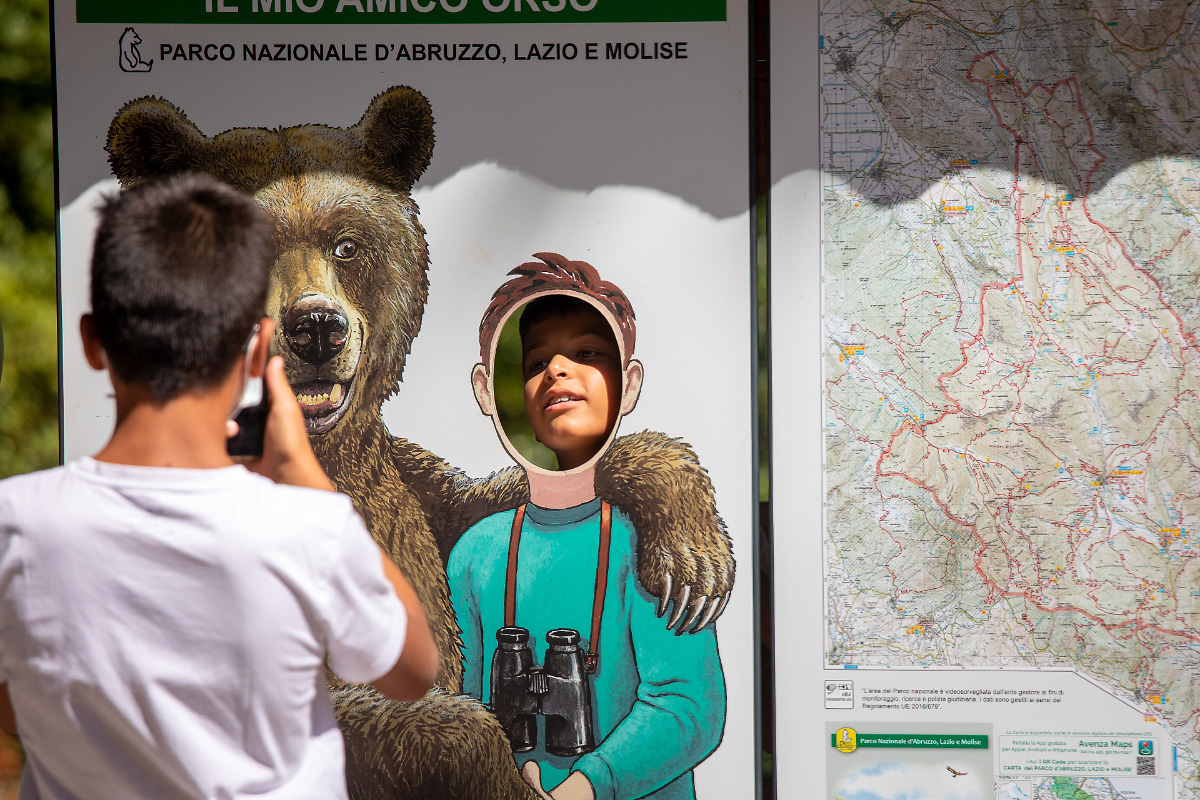
Children play with an ALMNP sign depicting the Apennine bear. Compared with other contexts, the perception of the large plantigrade is particularly positive here.
To satisfy its energy needs, a bear must be sure of a varied and flexible diet rich in nutritious foods and be free to move about within hundreds of square kilometres of the environmental mosaic of forests, mountain grasslands, cultivated fields and pastures produced by millennia of coexistence between man and the environment in the Apennines. Bears are creatures of habit, in other words, they return regularly to their preferred locations, where they look for food or shelter along routes that could be defined as “traditional”. And this is how they prepare for the long winter to be spent fasting. For bears, the time available to eat and amount of food needed to build up their fat reserves are tyrants. So when possible, they prefer quiet territories far away from humans. Their adaptability is nevertheless amazing and certainly greater than our ability to accommodate them.
People are a real challenge, even for an opportunistic species like the bear and continue to jeopardise its future.
With his mining and building, productive activities such as arable and animal farming and recreational activities such as tourism and hunting, man has altered, fragmented and even destroyed entire “mosaics”. This is a real challenge, even for an opportunistic species like the bear. Hence its disappearance and numerical reduction in many countries, including Italy. Bears have not only lost “ground”, they have also been hunted and persecuted, particularly in southern Europe, where bears were decimated quite recently (the last 200 years). In Italy, bears became extinct in the Alps and in most of the Apennines. In the middle of the last century, a few dozen individuals managed to survive high up in the mountains of the Abruzzo, Lazio and Molise National Park and its immediate surroundings. This was doubtless due to the harshness and wildness of the area, but also to a gradually growing process of awareness and protection.
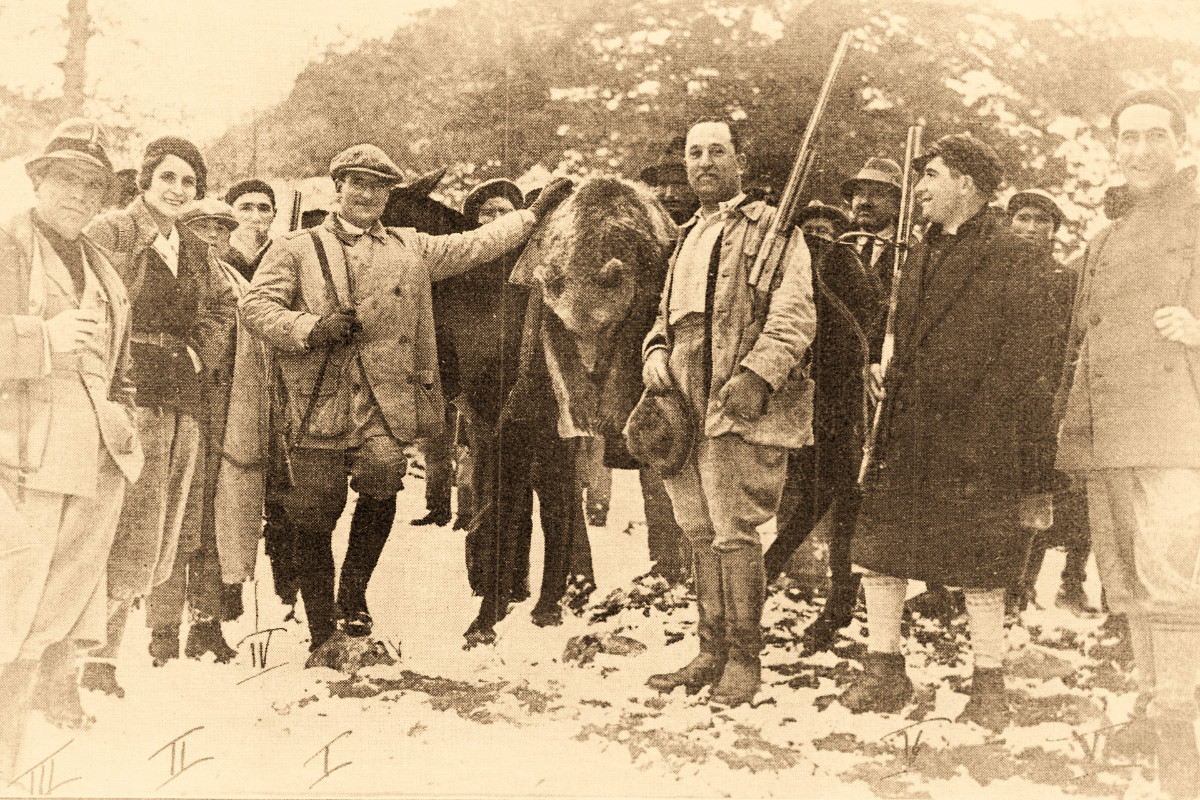
Vintage photo showing some notables and local personages involved in the last official bear hunt in the Abruzzo National Park in 1931. (© Archivio M.Mancini – Campobasso)
But the dangers and threats have not disappeared completely. With his heavy footprint, man continues to jeopardise the future of this now vulnerable animal. Bears are few in number and therefore very susceptible to catastrophic events that could decimate the population in the coming decades. Every year they die at levels not considered compatible with a growth in their numbers. These animals are genetically fragile, as millennia of isolation and a drop in numbers have depleted their genetic makeup, making them less adaptable and too closely related to one another. This exposes them to the adverse effects of inbreeding depression, such as reduced fertility and infant survival.
But all is not lost. The good news is that Marsican bears are surprisingly viable from a reproductive point of view. So researchers believe that by reducing mortality, this subspecies could return to repopulate the Apennines (over the 5000 km2 available) with an autonomous and viable population of over 200 bears. Although there is still room for bears in Central Italy, some areas are too fragmented and risky for the females. In the wild, bears can reach up to 30 years of age, but even today, humans are the direct or indirect cause of over 80% of bear mortality. Over the past two decades, up to five bears have died at the hand of man in a year. If you go back another 30 years, dozens of bears were killed.
These are alarming numbers, especially given that deaths include the few adult females able to reproduce and those trying to occupy new areas of possible expansion for the species. But what do bears die of in the Apennines and what are the factors of conflict?
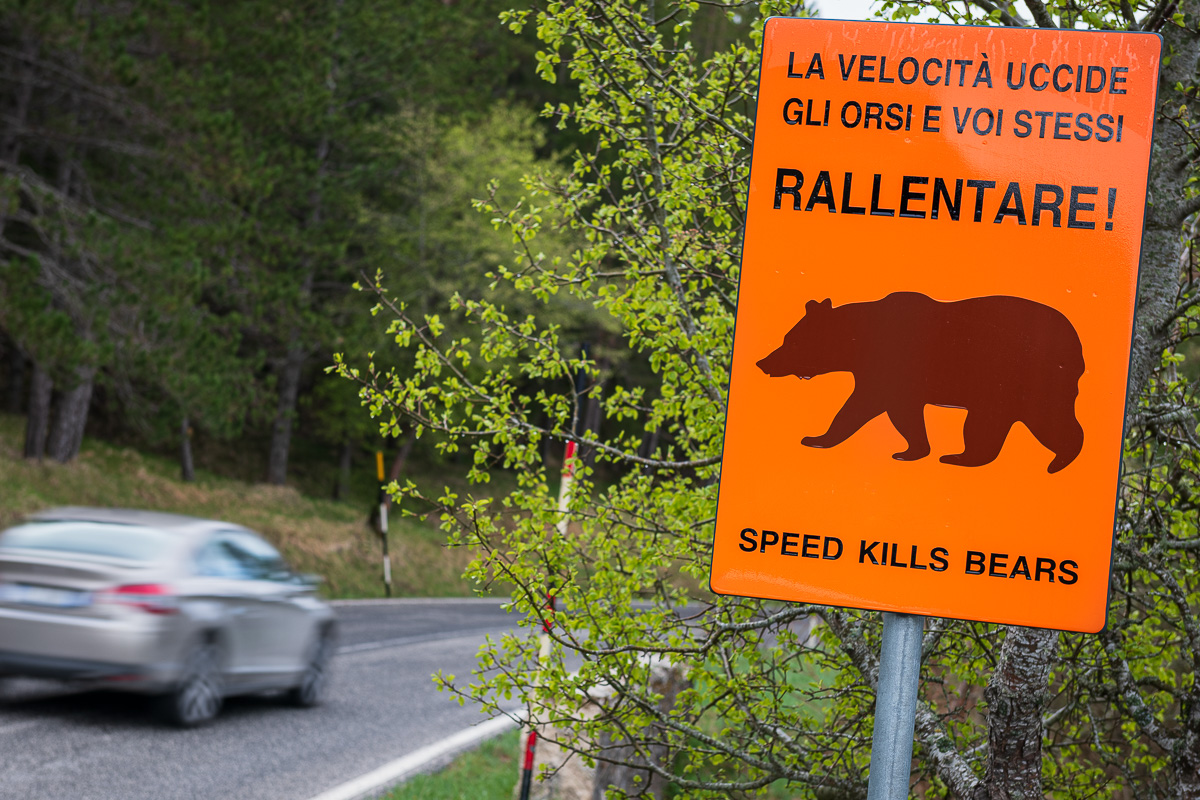
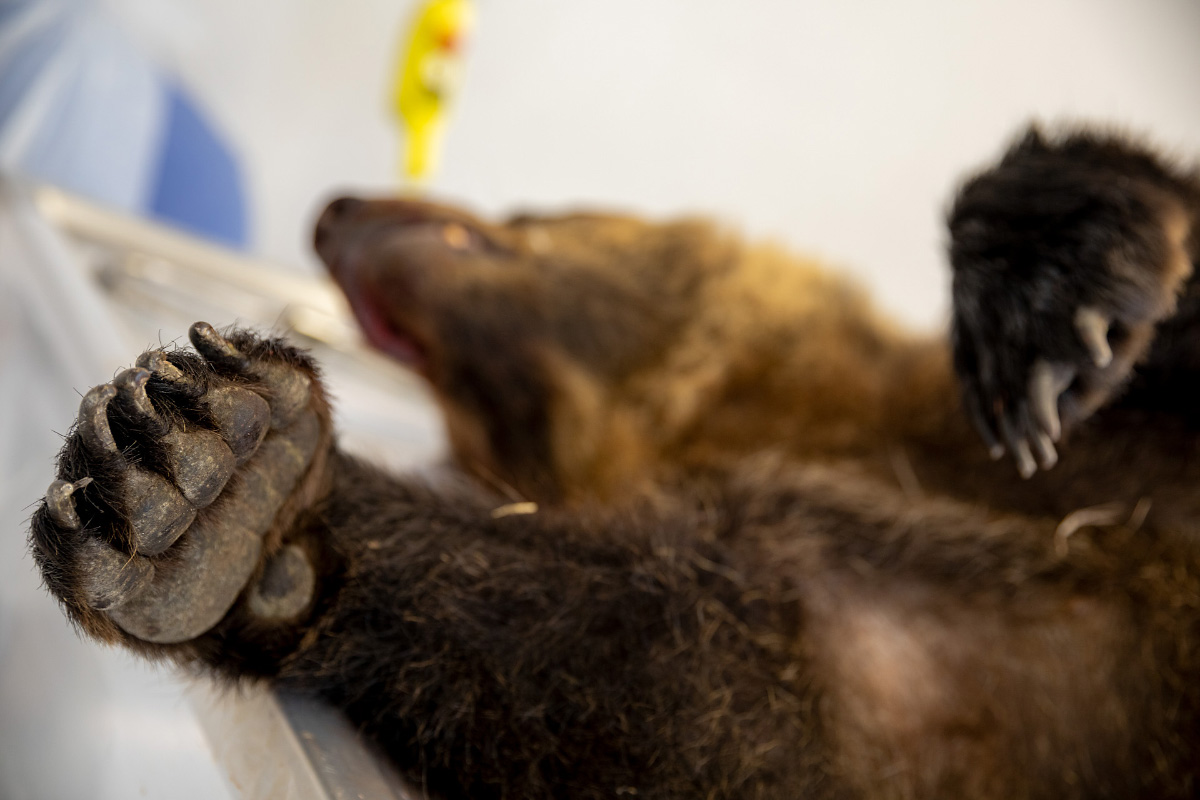
Left – A sign urges drivers to drive slowly in areas where bears are present. Right – A bear hit by a vehicle and killed in Molise in 2019.
The presence of both tarmac roads and dirt tracks not only increases the risk of bears being hit by vehicles, but also makes the area permeable, facilitating poaching from which bears are not immune. Roads with heavy traffic, such as highways and motorways, act as barriers to the bears’ movements, limiting the population’s opportunities to expand. Females are the most susceptible and their lack of dispersal is the main obstacle to the creation of new breeding nuclei outside the National Park. Solutions do exist to reduce the risks, but they require collaboration between institutions and the public: road education, structural interventions, suitable signs and sound and/or light warning systems for drivers and animals.
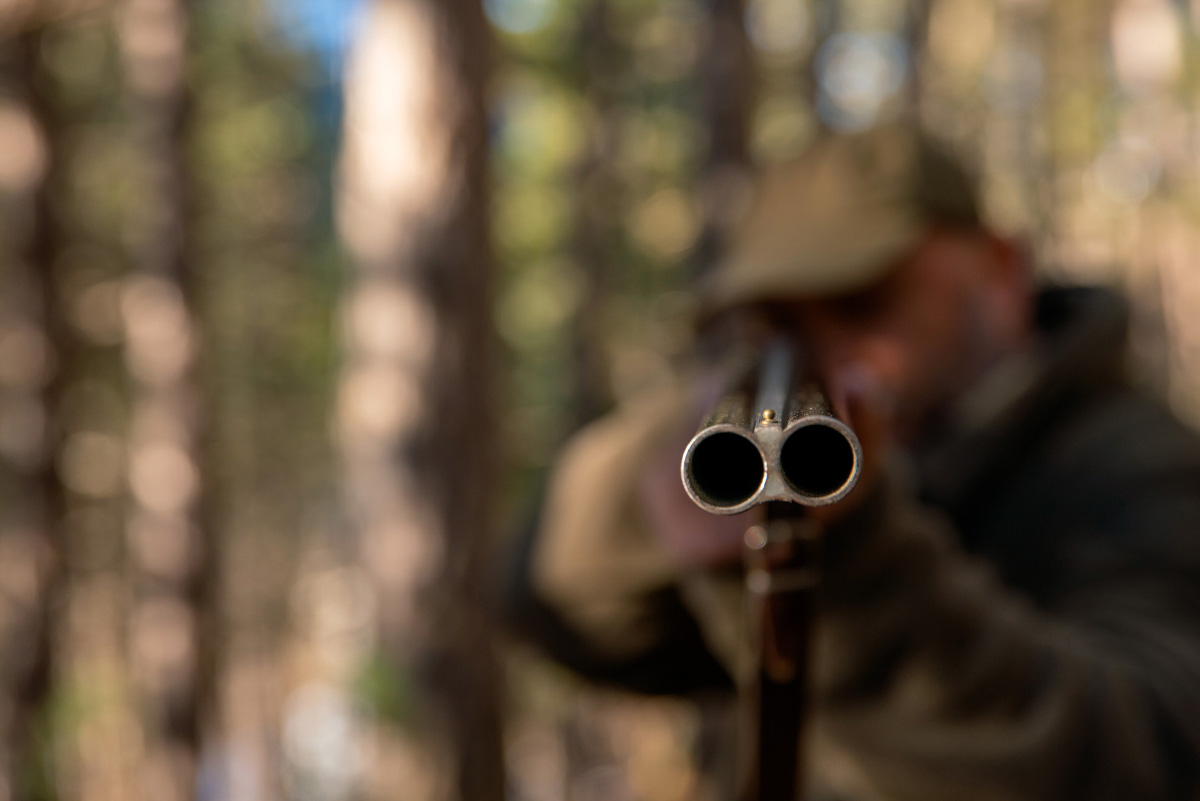
Bears that venture outside the boundaries of protected areas are at greater risk of being involved in hunting accidents or poaching.
Bears can fall victim to firearms, snares placed by poachers to capture ungulates, or poisoning. Sometimes bears are also killed accidentally during hunts. Regardless of cause of death, autopsies have revealed shot pellets lodged in the bodies of most of the bears found dead. This underscores the risks these animals face during the autumn when they try to cross unprotected territories or the buffer zones of a National Park. These problems could be solved by a greater and better coordinated law enforcement effort and the adoption of hunting methods more compatible with the presence of bears.
Bears sometimes kill livestock or damage beehives and some individuals have made a habit of venturing into villages in search of easy food, such as fruit, vegetables and unprotected farmyard animals. These situations can lead people to feel insecure economically, but also uneasy and afraid for their safety. The phenomenon of bears becoming accustomed to the presence of man is also a worry for the authorities, especially in protected areas where the phenomenon could increase in the coming years, given the boom in fruition of these areas. There are also concerns for the increase in opportunities for close encounters between bears and people, with potentially unpredictable outcomes. In the Apennines, there is no record of attacks or injuries, not least thanks to the docile nature of this subspecies. However, such an event is to be avoided at all costs, as it could represent a source of unpopularity or fear, or lead to a bear being removed from the wild, a huge damage for such a tiny population of individuals.
But all is not lost. Prevention and incentive systems have been identified and could help mitigate conflict, if implemented in collaboration with the various interest groups. Furthermore, given that climate change could affect the availability of natural food resources, prevention and environmental restoration are priorities to avoid the risk of increased conflict.

A bear in search of fruit crosses a village in the ALMNP during the night. (© Marco Colombo – www.calosoma.it)
Over the last 20 years, especially in protected areas, there has been a boom in tourism in areas frequented by bears, partly aimed at experiencing nature and observing the animals. Although the economic benefits for local populations and for the image of the bear and its conservation are unquestionable, the pressure exerted on the environment and the animals can be excessive and further regulation is required. There is evidence that bears can experience nutritional deficits if disturbed or obliged to move away from their optimal food sources. Female bears are evolutionarily programmed to adapt to changes in the amount of food in the wild, but at great cost. If the fecundated bears fail to reach the right weight in autumn, the foetus may be reabsorbed and the female will leave the den in spring without cubs. Bears are also particularly sensitive in winter. For example, if disturbed in the den, females may abandon their cubs. These stories without a happy ending are alarming, considering the extreme vulnerability of the Apennine bear. But these activities can be carried out in an ethical manner, minimising disturbance to the animals.
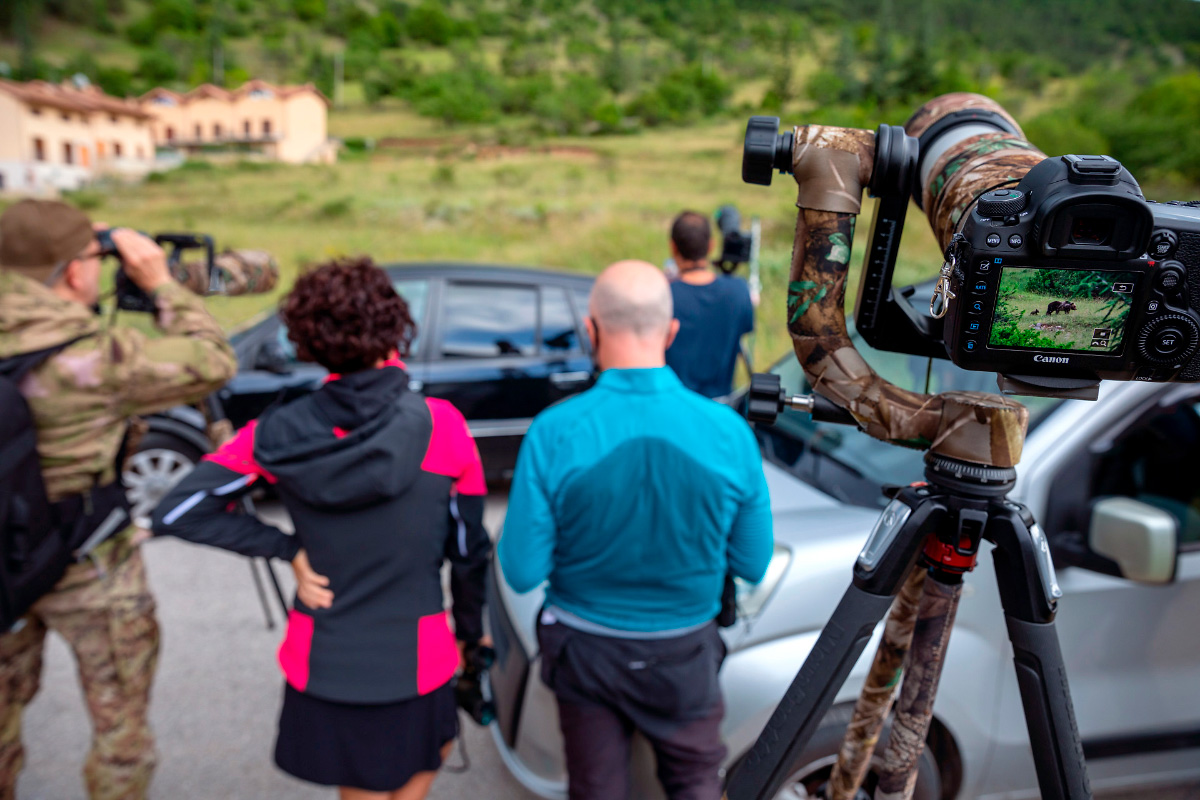
Enthusiasts, photographers and the curious concentrate on the outskirts of a village to get a close-up look at a family of bears.
There are still real opportunities to protect bears and more than one reason to protect them.
More than 60% of the area frequented by bears and their possible future expansion zone is covered by various forms of protection. This provides real opportunities for planning and controlling the territory to protect the bears. However, the risk of bears encountering a fatality is very high, even in a protected area. All the conditions are therefore right for the population to grow in numbers and expand, but not without a renewed effort to protect the bears, giving priority to certain types and methods of intervention. The solutions are complex and require time and the involvement of all sectors. From central government to the local authorities and from management bodies to associations, interest groups and the general public, we all need to work together to find long-term solutions. Since the establishment of the Abruzzo, Lazio and Molise National Park, much has been done to protect the bear, in collaboration with various interested parties, also beyond the borders of the Park. An encouraging basis from which to tackle what remains to be done.
Why conserve bears? Attempting to answer this question is to enter a multidimensional universe. The most immediate answer is that the bear is protected by international and national laws and, democratically speaking, its protection is therefore desired by the majority. On the other hand, from an ethical standpoint, bears are living beings like us and as such deserve to exist. But we human beings are still made up of values, perceptions, emotions, prejudices, cultures, interests and experience. All we can do is try and strip away all the skins man has dressed bears in to rediscover their natural and undeniable role.
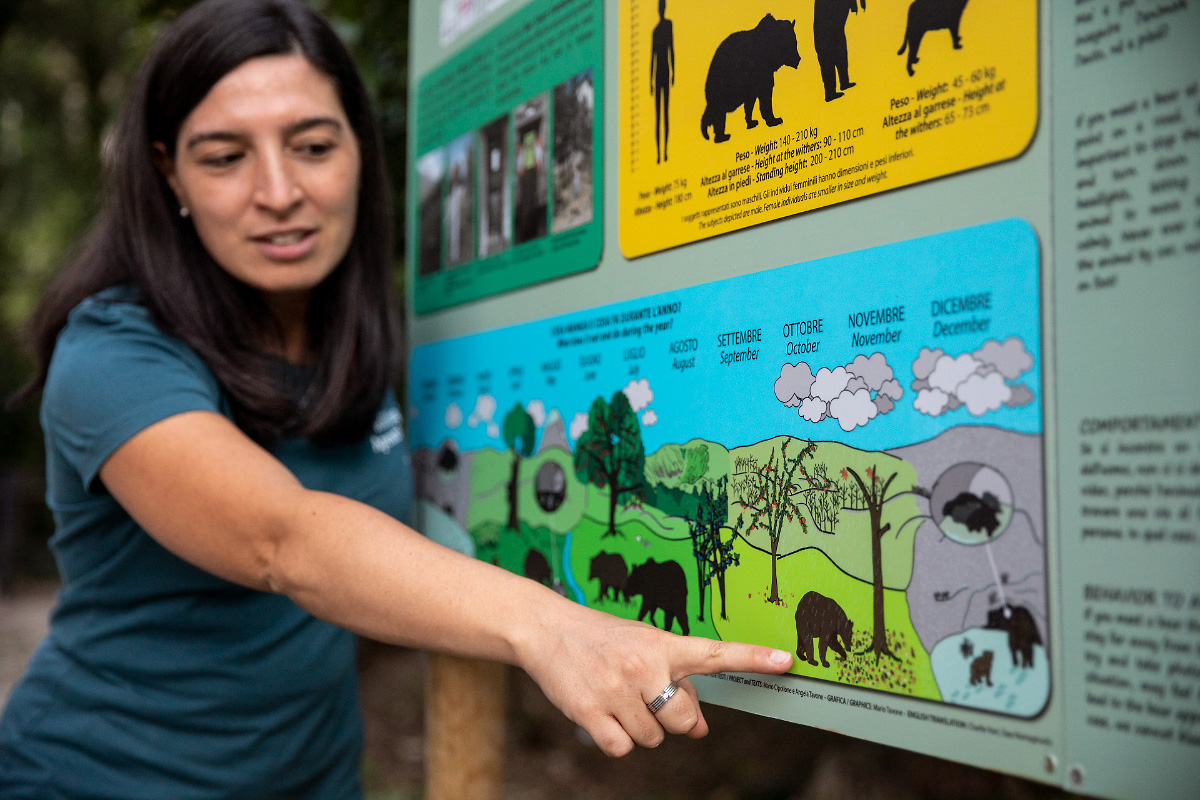
An information panel illustrates bear biology in the municipality of Pettorano sul Gizio (L’Aquila), seat of a Bear Smart Community project.
Their need for vast spaces makes bears true sentinels. Their presence indicates a healthy and diversified ecosystem, able to ensure the survival of a wide variety of species. Bears have a function in ecosystems because they are interconnected with the communities of plants and animals with which they share the space. Through their digging, the excrement they deposit and the remains of food they leave, they fertilise the soil, making the plants more productive and enriching the waters. By spreading the seeds of many fruit plants through their droppings, bears provide food for rodent populations. A bear can change the life of an ant as well as that of a tree. Ensuring the future of bears means preserving an entire ecosystem and also ensuring the survival of every other species, including our own. But preserving bears also means saving the identity of many peoples and cultures, not least in the Apennines.
Alive, the grizzly is a symbol of freedom and understanding – a sign that man can learn to conserve what is left of earth. Extinct, it will be another fading testimony of things man should have learned more about but was too preoccupied with himself to notice. In its beleaguered condition, it is above all a symbol of what man is doing to the entire planet. If we can learn from these experiences, and learn rationally, both grizzly and man may have a chance to survive.
– Frank Craighead –

